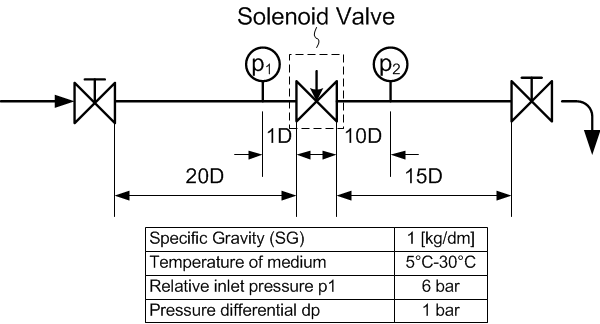Definition Kv-value: Amount of flow (m3/hour) of water of 20°C in a valve with a pressure loss of 1 bar.
The amount of flow of a fluid through a (solenoid) valve can easily be calculated with flow coefficient Kv. Please note that for gases (e.g. air) a different formula is used (see correction factor gases below).
The Kv-value expresses the flow rate of water in m3/hour in a valve with a pressure loss of 1 bar and a temperature of 20°C. Pay attention that the Kv-value is expressed in m3/hour, while the kv-value (lowercase!) is expressed in l/min.
To calculate the flow rate the following formula is used:
where:
The Kv-value of a valve is determined by a standardized test according to VDI/VDE 2173. For this purpose a test set-up is used, such as shown in the following schematic drawing:

Sometimes, the Cv value is given instead of the Kv value. The Cv value can be converted to the Kv-value with a conversion factor:
The diagram below is a nice tool to simplify the conversion between the different coefficients. The conversion factor between two coefficients is indicated with arrows.
Kv (with a capital K) expresses the flow rate in m3/hour, kv (lowercase) in l/min.
If several valves are connected in parallel, the Kv value can be determined simply by adding up all Kv values.
When using gases, a different formula for the flow rate should be used. Also, a distinction between subsonic and supersonic flows is made. “Qn” indicates that the formula is valid for standard conditions (20°C).
The flow rate is expressed in Nm3/h (Normal cubic metre per hour).
Where:
The Kv-value must be at least 0.3.
Also Read: Control Valve Cv Calculation
This article explains how to blink lights in ladder logic with a detailed explanation video…
In this article, a simple example will teach you the conversion from Boolean algebra to…
In this article, you will learn the PLC cooking timer example for kitchen automation using…
Learn an example PLC program to control a pump based on level sensors using ladder…
In the PLC timer application for security camera recording, when motion is detected then camera…
In this example, we will learn batch mixing with PLC ladder logic program using timer…
View Comments
How we need to calculate Size and percentage of opening of valve? is there any cv table for solinoid valve